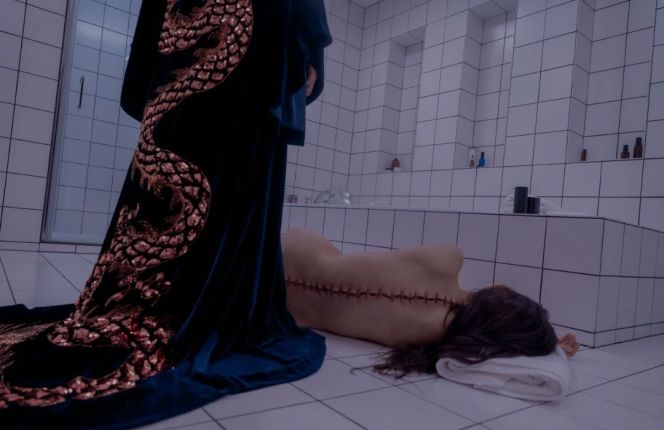MOVIE REVIEW – Demi Moore and Margaret Qualley star in a visionary feminist body-horror that plunges deep into the extreme, hyperreal world of the beauty industry. Director Coralie Fargeat blends the stylistic elements of grindhouse with Kubrick’s meticulousness in this grotesque yet captivating film, which merges elements of Dr. Jekyll and Mr. Hyde with Showgirls in a truly unique mix.
Shocking and memorable, grotesque yet oddly entertaining, The Substance is a feminist body-horror film that deserves a spot in every cinema. That’s not to say it has the elegance or intellectual depth of a David Cronenberg film, nor is it a postmodern punk oddity like Titane. Coralie Fargeat, the writer-director, operates in a bold, in-your-face style that’s vividly accessible and daringly extreme. She employs a host of modern horror visual elements, but unlike the majority of such films, The Substance is driven by a clear and thought-out vision. There’s something primal, almost instinctual, in what she wants to convey to the audience.
Doppelgänger of Youth
The Substance tells the story of an aging Hollywood actress turned aerobics host, Elisabeth Sparkle, played by Demi Moore. Elisabeth is fired from her TV gig because she’s deemed too old. In desperation, she calls a mysterious number she was anonymously given, which leads her to a sci-fi body-enhancement program called The Substance. She receives medical supplies (syringes, tubes, a phosphorescent green liquid, and a white, jelly-like injectable substance) and is instructed on how to use her new self—which is also her old self. “You are one and the same,” the instructions say. But what does that mean?
It means that after injecting herself, Elisabeth passes out on her bathroom floor, her skin splitting down her spine, and—much like the alien creatures in Invasion of the Body Snatchers—her new self emerges: a “perfect” version of youthful, sexy femininity, played by Margaret Qualley. The deal is simple: the new self, named Sue, gets to live in the world for one week. During that time, she becomes a star and gets her own show, Pump It Up with Sue. A star is born. But after her week is up, Sue must go into hibernation while Elisabeth, with her old body, returns. The two live in turns, feeding off one another, allowing Elisabeth to “be” Sue every other week. It’s like Dr. Jekyll and Mr. Hyde rewritten as a billion-dollar cosmetic industry nightmare.
Kubrick Meets Grindhouse
Fargeat, who previously directed the 2017 film Revenge, works in a wide-angle, exploitation-film style that can best be described as grindhouse Kubrick. It’s as if the aesthetic of A Clockwork Orange merged with the fast-paced visuals of a modern TV commercial. Fargeat is fond of extreme close-ups (of body parts, cars, eating, kissing), which she pairs with matching sound effects. Like Brian De Palma, she absorbs cinematic influences (with De Palma himself being one of them). We’ve seen countless retellings of Dr. Jekyll and Mr. Hyde, but Fargeat takes it even further, mixing in elements of Showgirls, and even that’s not enough for her.
One major influence is the iconic scene in The Shining, where Jack Torrance embraces a young woman in a bathtub, only to see her transform into a horrifying old hag. Fargeat’s visuals also evoke John Carpenter’s The Thing, Stephen King’s Carrie and its bloody prom scene, as well as the nightmarish addiction themes from Requiem for a Dream.
What makes Fargeat’s work truly distinctive is how she blends her aggressive, stylized voice (with dialogue that snaps like something out of a graphic novel) with her feminist outrage over the control imposed on women by the world of image. At first, the over-the-top style may take some getting used to. Dennis Quaid plays a pompous, self-absorbed TV executive who decides to fire Elisabeth, and during their lunch, he disgustingly stuffs shrimp into his mouth while sitting only inches away from the camera. The scene is so repulsive that we recoil just as Elisabeth does. Yet Fargeat excels in directing her actors; she knows that Quaid’s charisma, even when playing such a repugnant character, will keep viewers glued to the screen.
Freedom and Control
Demi Moore’s performance is bold and fearless. In an abstract way, she plays a version of herself: once the center of the universe, now too old to be taken seriously by a sexist Hollywood. Her performance is infused with anger, fear, despair, and vengeance. The Substance is filled with explicit nude scenes, to the point where the film plays with the aesthetics of the male gaze—only to completely subvert and dismantle it later. Margaret Qualley portrays Sue with confident poise, knowing full well how to “sell” herself as an object, making this a key part of the film’s satirical message. She follows the rules and “gives people what they want.” It’s clear that Qualley is on the verge of becoming a major star, and The Substance shows us exactly why. She brings a stylized role to life with a touch of mystery. Ultimately, The Substance is a battle between two egos: Elisabeth’s real self and her youthful self, fighting for dominance.
They’re supposed to be partners—in fact, they are technically the same person—but when Sue, drunk on being Sue, overstays her week and drains even more of Elisabeth’s life energy, it’s Elisabeth who pays the price, as her body rapidly begins to age. The film’s metaphors are deeply organic. In our world, we can attain a “new” self through physical enhancement, but the film suggests that in doing so, we become a parasite, draining our old, perhaps real self. And there’s only so much of “you” to go around.
Kafkaesque Transformation
The Substance truly plays off Showgirls and the history of Hollywood catfight melodramas. The film’s ambitions are almost delirious (at 140 minutes, it could easily lose 20). But as it reaches its final chapter, the restrained body horror erupts into something cathartic and extreme. By this point, Sue has drained almost all of Elisabeth’s life, leaving her body so decayed that she makes the bathtub hag in The Shining look like Grace Kelly. But Fargeat is just getting started. The climactic sequence takes place during the taping of the network’s New Year’s Eve special, which Sue is hosting, and what unfolds must be seen to be believed. Even if you watch horror films all year, this one stands out as a rarity that delivers a true monster—not just in the form of warped flesh, but a deformation of the spirit. The film’s message is clear: this is what we suppress. This is what we’re doing to ourselves.
– Gergely Herpai “BadSector”-
The Substance
Direction - 8.2
Actors - 8.4
Story - 8.6
Visuals/Music/Sounds - 9.2
Ambience - 8.8
8.6
EXCELLENT
The Substance is a feminist body-horror that grotesquely but entertainingly explores the extremes of the beauty industry. Demi Moore and Margaret Qualley deliver standout performances, while Coralie Fargeat’s direction is both daring and visually stunning. The film pushes emotional and visual boundaries while posing thought-provoking questions about our self-image and the limits of our bodies.


















Leave a Reply